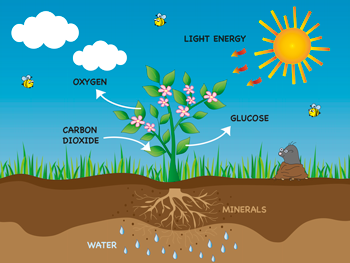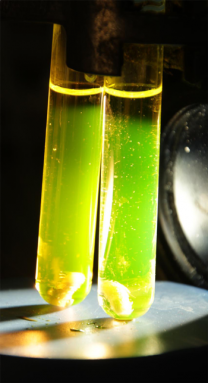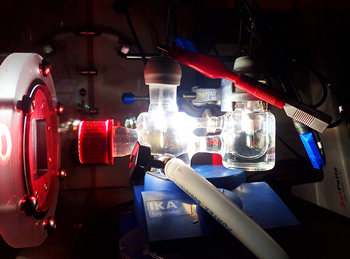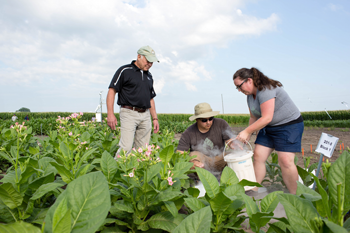Scientists look to hack photosynthesis for a ‘greener’ planet
Plants serve as the inspiration for new energy technologies — and more efficient agriculture

Scientists are looking at how plants turn sunlight into sugars — a process known as photosynthesis — as a model for cleaner ways to produce energy for people and industry. Their research even suggests ways people can help plants photosynthesize more efficiently.
Xurzon/iStock /Getty Images Plus
Photosynthesis comes as naturally to plants as breathing does to people. This process converts the simple ingredients of carbon dioxide, water and sunlight into energy. Photosynthesis allows plants to grow. In turn, we rely on photosynthesis as the foundation for our life on Earth.
Carina Baskett recalls the first time she learned about photosynthesis. She says, “I remember feeling like, this seems so magical.”
She’s now a plant biologist at the Institute of Science and Technology Austria in Klosterneuburg. “It’s just so amazing that plants are taking air, water and light — things we walk around in, all the time — and they’re turning that into energy and food for the whole world.”

The sun’s energy makes us feel warm when it hits our bare skin. But when sunlight touches the leaves of a plant it does more. It powers a chemical reaction that converts one type of energy into another. Those plant leaves contain plenty of water. That water is made of oxygen atoms bonded to hydrogen atoms. The sun’s energy can excite electrons inside the water molecule enough that the bonds split.
This triggers a reaction “that takes the oxygen away from the water. And that becomes the oxygen in the air that we all breathe,” explains Baskett. Meanwhile, she notes, “Hydrogen from the water gets smushed together with the carbon dioxide [in air], and that makes sugar.”
People and all other animals use this sugar — glucose — as an energy source from food. Plants become the food that our bodies can convert into energy. Essentially, photosynthesis is the reason we can exist, Baskett explains.
It’s no mystery why photosynthesis fascinates her and other scientists. Many of them now want to know more about it, imitate it — even improve upon it.
Blinking plants
The basics of photosynthesis are well-known. Chlorophyll, the green pigments in plants, use sunlight to make sugars. But there’s still a lot to learn about how plants control the process and its efficiency. Enter Avihai Danon. He’s a plant biologist at the Weizmann Institute of Science in Rehovot, Israel. He studies how plants regulate, or control, photosynthesis. In a paper published last year in iScience, his team described one such process. He describes it as plants “blinking.”

“Too much light can actually burn the plant’s cells,” says Danon. He compares a plant exposed to too much light to a person playing with electricity. “If suddenly there is a rise in light level, how do they handle it? Do they get burned?”
Any gardener knows plant species are adapted to live in particular amounts of sunlight. But light conditions naturally change. Clouds travel across the sky, wind ruffles leaves and the sun’s position moves throughout the day. To study how photosynthesis adjusts to these changes, Danon studied mustard plants in his lab under low light.
In one test, he increased the light’s intensity every 10 minutes. This was to mimic the rising sun. As the light changed, Danon measured the plant’s fluorescence (Fluor-ESS-ents). This is a form of light energy released by photosynthesis. Measuring the fluorescence helped Danon see how much photosynthesis occurred under different levels of light.
As the day brightened, Danon expected to see a steady increase in photosynthesis. Instead, the pattern resembled more of a flicker. Photosynthesis would slow way down, and then bump back up a little. Down, and then up. Again and again, little by little, it adjusted to the strengthening light.
“It’s taking a better-be-safe-than-sorry approach,” Danon explains. The plant was anticipating the worst conditions, he says, before adjusting to the actual changes.
Danon couldn’t help but draw a comparison to how human eyes respond to sudden, bright sunlight. When we step outside on a sunny day, our pupils constrict. That response protects our eyes from damage while making sure we still can see important things around us.
Plants can’t move, so their “blinking” helps protect them from burning or bleaching when they are in bright sun. A plant’s light gauges — you can think of them as antennae — register when light levels change. These antennae shrink, and in the process reduce photosynthesis. This shrinking also protects them from sudden changes that might damage the entire plant.
Danon is inspired by what plants can do. “If plants have developed this type of very sophisticated response, and they are successful for hundreds of millions of years, maybe it can help us in our own engineering,” he says.
Artificial photosynthesis
Scientists have already begun copying, or mimicking, photosynthesis. Their artificial processes also use light to split oxygen and hydrogen — for energy. The dream is to eventually replace fossil fuels. If people could make energy from sun, air and water — as plants do — it would cut down on planet-warming releases of carbon dioxide. It also could create a huge new source of renewable energy.
Many researchers look to solar fuels — fuels made from sunlight — as “green” replacements for today’s carbon-based fossil fuels. These include oil, gas and coal.
Solar fuels can take many forms. They might look like traditional carbon-based fuels, using carbon dioxide to “recycle” emissions from fossil fuels. Hydrogen and oxygen, the chemical products of photosynthesis, can power fuel cells that allow cars to run on electricity. Also, solar energy can convert sunlight into electricity that could be stored in batteries. No matter what form solar fuels take, the first step is splitting water into its elemental building blocks.
“Nature has this power,” explains Julien Warnan. He’s a chemist working with Erwin Reisner on solar fuels at the University of Cambridge in England. Nature has had a lot of time to figure out how to do this efficiently, he notes. When it comes to splitting up water’s building blocks, engineers are “a bit more limited,” he says. “Everyone is trying to develop different tools to do it.”

Last year in the journal Nature Energy, Warnan’s team described a new way to use sunlight to split water. The idea, Warnan explains, “is to take water and air and put that together in a box.” Then you add a catalyst. This is some material that can trigger chemicals to react. Later, he says, “You shine light on this box. And what comes out is fuel — like what you put in your car or a plane.”
Scientists around the world are experimenting with devices — think of them as artificial leaves. Like the processes in leaves, they split water into hydrogen and oxygen. Warnan’s team wasn’t the first to do it. But they did it with a different type of catalyst. It’s the same one that a plant uses to jump-start a chemical reaction.
They extract that catalyst from a plant, rather than creating it from chemicals in a lab. That means fewer harsh chemicals would go into making their solar fuel. But more work is needed before people can produce a solar fuel from water as easily as plants can.
“The great power of the plant is that it can always regenerate and replenish [the catalyst] if it breaks down,” says Warnan. “We cannot.” This type of solar fuel, therefore, “is still very expensive,” he points out.
So don’t expect to gas up with solar fuels in the near future. The current devices cannot harvest enough sunlight affordably. That’s why plants are such good teachers. Having done photosynthesis for millions of years, they’ve already figured out how to do it efficiently.
Energy analysts predict that people will use twice as much energy by 2050 as they do now. Artificial leaves could be one way to wean humanity off its dependence on fossil fuels.
Hacking plants
Nearly 8 billion people share our planet today. The United Nations estimates that there will be 9.7 billion people living on this warming world by 2050. They will stretch the demand for food and energy to its limits.
Photosynthesis has evolved to work as well as it needs to — for plants. One group of scientists is now looking to improve upon photosynthesis — this time, for people. RIPE, which stands for Realizing Increased Photosynthetic Efficiency, is a global research effort. It aims to “hack” photosynthesis in ways that could yield more crops.

Amanda Cavanaugh is a plant biochemist at the University of Illinois in Urbana. She works with RIPE. Her research focuses on one tiny enzyme that has a big impact on photosynthesis. It’s known as Rubisco (Roo-BIS-koh).
“It doesn’t get a lot of credit, but it has arguably the most important job in the world,” she says.
Rubisco grabs carbon dioxide out of the air and helps convert it to sugar, or glucose. That’s the process that makes plants into an energy-conversion system that fuels the growth of animals.
All photosynthetic life relies on the Rubisco enzyme, Cavanaugh says. And while “it’s critically important,” she adds, “it’s not particularly good at its job.”
She’s talking about a common mistake that plants make during photosynthesis. About one in every five times, a plant will “grab” an oxygen molecule from the air instead of carbon dioxide. That’s like accidentally putting salt in coffee rather than sugar. So instead of making energy for the day, the plant produces toxic compounds.
Plants have come up with a way to recycle the unwanted compounds. But doing this uses energy that the plant might otherwise put into growth. If science could figure out a way to correct Rubisco’s mistake, Cavanaugh estimates, agriculture could feed another 200 million people a year.
“For years, people have been fascinated by the possibility of engineering a better Rubisco,” she says. Doing so might allow farmers to “grow more food on less land.” And that, she argues, is “the ultimate goal for a plant biologist.”
When Rubisco makes those mistaken compounds, a plant gets rid of them. It does that by transporting these unwanted chemicals to three different structures within the plant cell. Cavanaugh and her colleagues saw this “recycling” process as wasting a plant’s precious energy and time. “We wondered if there was a way to speed that up,” she says.
IGBIllinois/YouTube
To find out, she and her colleagues worked with tobacco plants in a greenhouse. (Tobacco is not a food crop, but they used it because it’s quick to grow.) The researchers tested plants having somewhat different genetic traits. Then they “starved” these plants of the carbon dioxide they needed to grow. The plants’ Rubisco responded by making lots of mistakes.
The plants that thrived under these conditions proved to be the best recyclers of the toxic compounds.
Then the scientists grew the super recyclers in farm fields. These tobacco plants grew 40 percent larger than normal. The researchers described their engineering feat last Jan. 4 in Science.
The next step is to apply the lessons learned in tobacco to crops, such as potatoes, cow peas and soybeans. Cavanaugh is excited about the likely success of moving this photosynthetic hack into food plants.
“Photosynthesis is one of the best understood biological processes in life,” says Cavanaugh. “But there’s so much we don’t know about it. It’s now starting to open up in a really neat way.”







